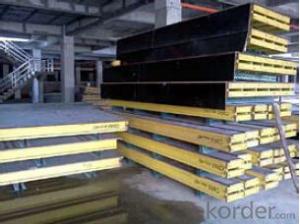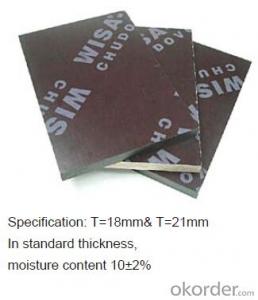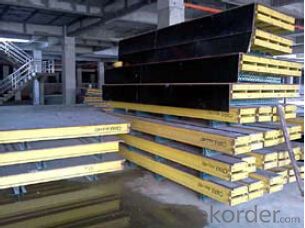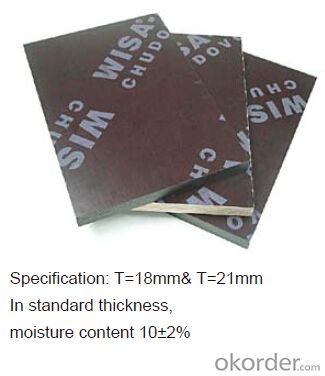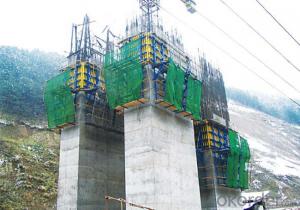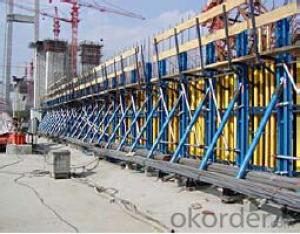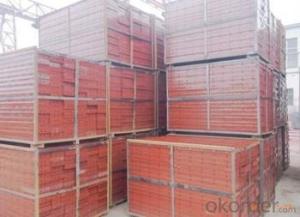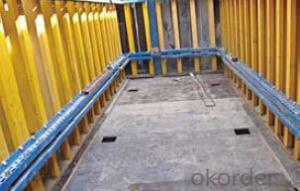Plywood formwork system and scaffolding system
- Loading Port:
- Tianjin
- Payment Terms:
- TT OR LC
- Min Order Qty:
- 50 g/m²
- Supply Capability:
- 1000 g/m²/month
OKorder Service Pledge
Quality Product, Order Online Tracking, Timely Delivery
OKorder Financial Service
Credit Rating, Credit Services, Credit Purchasing
You Might Also Like
Plywood --- make perfect concrete surface
WISA-Form Birch is a coated special plywood using in the formwork systems where high
requirements are set on the concrete surface and the times of reuses.
With CNBM timber beam & WISA plywood, the formwork is low weight but high load capacity, it is
widely used in construction.
Characteristics:
◆ Component with high standardization.
◆ Assembling in site, flexible application.
◆ Light weight, easy transportation and storage.
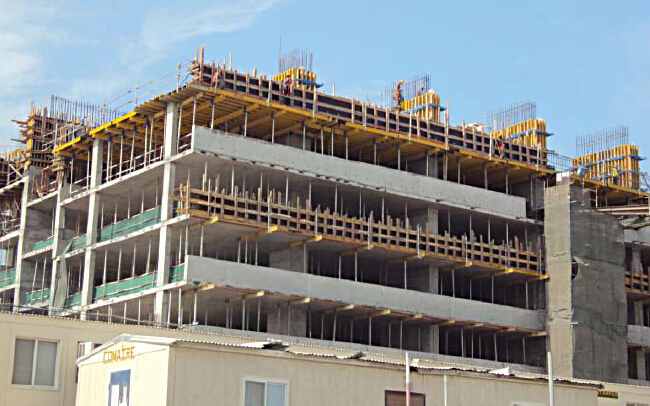
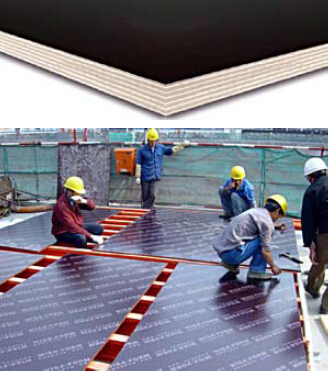
- Q: How does steel formwork contribute to the overall speed of construction?
- Steel formwork contributes to the overall speed of construction by providing a durable and reusable solution for creating concrete structures. The use of steel formwork allows for faster and more efficient construction processes as it can be easily assembled and disassembled, reducing the time required for formwork installation and removal. Additionally, steel formwork provides a smooth and consistent surface, resulting in faster curing times and improved productivity.
- Q: How does steel formwork affect the overall sound insulation of a building?
- Steel formwork does not directly affect the overall sound insulation of a building. However, it can indirectly impact sound insulation by influencing the type and quality of materials used for insulation purposes. The choice of materials for sound insulation, such as the selection of appropriate insulation panels or acoustic barriers, will have a greater impact on the overall soundproofing performance of a building.
- Q: What are the different sustainability aspects of using steel formwork?
- There are several sustainability aspects associated with the use of steel formwork in construction projects. First and foremost, steel is a highly durable material that can withstand heavy loads and extreme weather conditions. This means that steel formwork can be reused multiple times, reducing the need for frequent replacements and minimizing waste generation. Additionally, steel formwork is resistant to warping, shrinking, and expanding, ensuring consistent and accurate dimensions in the construction process. Another important sustainability aspect of steel formwork is its high strength-to-weight ratio. Compared to other formwork materials, such as wood or plastic, steel is much lighter while still maintaining its structural integrity. This reduces the amount of energy required for transportation and handling, thereby decreasing carbon emissions and fuel consumption. Furthermore, steel is a recyclable material. At the end of its lifespan, steel formwork can be easily dismantled and sent to recycling facilities where it can be melted down and reused to manufacture new steel products. This helps to conserve natural resources and reduce the demand for virgin materials. Moreover, steel formwork offers significant time and cost savings. Its reusability eliminates the need for constant purchases of new formwork materials, reducing construction expenses. Additionally, the ease of assembly and disassembly speeds up the construction process, resulting in shorter project durations and reduced energy consumption. Lastly, steel formwork provides a smooth and uniform surface finish, reducing the need for additional finishing materials such as plaster or paint. This reduces material consumption and waste generation, contributing to a more sustainable construction process. In conclusion, the use of steel formwork in construction projects offers various sustainability benefits, including durability, reusability, recyclability, energy efficiency, cost savings, and reduced material consumption.
- Q: How does steel formwork affect the overall sustainability of a construction project?
- The overall sustainability of a construction project can be significantly influenced by the use of steel formwork. Firstly, the durability and reusability of steel formwork greatly reduces the need for constant replacement, resulting in minimal waste generation and a reduced environmental footprint. This not only benefits the project's environmental impact but also aids in cost reduction. Additionally, the use of steel formwork ensures a high level of accuracy and precision, leading to efficient and streamlined construction processes. This in turn reduces material wastage and energy consumption, contributing to the sustainable use of resources. Moreover, the utilization of steel formwork enables faster construction cycles, resulting in decreased overall energy consumption and greenhouse gas emissions. Furthermore, steel formwork offers versatility in design, allowing for the creation of complex and innovative architectural structures. This versatility enhances the aesthetic appeal of a building, promoting its long-term use and decreasing the likelihood of demolitions due to outdated designs. By extending the lifespan of a structure, steel formwork contributes to the sustainability of the project by reducing the need for additional construction and material usage. In addition, steel formwork plays a crucial role in ensuring the overall structural integrity and safety of a building. Its strength and rigidity provide stability during both construction and throughout the lifespan of the structure. This reduces the risk of structural failures and the need for repairs or reconstruction, consequently minimizing waste generation and resource depletion. To summarize, the use of steel formwork has various positive impacts on the overall sustainability of a construction project. Its durability, reusability, precision, efficiency, versatility, and structural integrity contribute to the reduction of waste generation, energy consumption, and greenhouse gas emissions. By promoting the sustainable use of resources and contributing to the long-term viability of buildings, steel formwork plays a crucial role in sustainable construction practices.
- Q: Is steel formwork suitable for projects with high wind loads?
- Indeed, steel formwork proves itself as a suitable option for projects grappling with formidable wind loads. Renowned for its robustness, longevity, and steadfastness, steel formwork emerges as an exemplary selection for construction ventures besieged by elevated wind loads. By adeptly thwarting wind forces, steel formwork remains unyielding to deformation or harm in the face of tempestuous winds. Moreover, steel formwork guarantees an exceptional degree of dimensional precision, fortifying the structure against the exertions of wind while preserving its stability. Thus, steel formwork stands as a dependable and fitting choice for projects that confront formidable wind loads.
- Q: Can steel formwork be used for retaining walls?
- Yes, steel formwork can be used for retaining walls. Steel formwork is a popular choice for retaining walls due to its durability and strength. It provides excellent support and stability to the concrete during the construction process. Steel formwork is capable of withstanding the pressure exerted by the concrete and the soil behind the retaining wall, ensuring that the structure remains intact. Additionally, steel formwork offers flexibility in terms of shape and size, allowing for the construction of various retaining wall designs. Overall, steel formwork is a reliable and efficient choice for retaining walls, offering long-lasting performance and ease of construction.
- Q: Are there any specific safety measures to be followed during steel formwork installation?
- Yes, there are specific safety measures that should be followed during steel formwork installation. Here are some of the most important ones: 1. Personal Protective Equipment (PPE): All workers involved in the installation of steel formwork should wear appropriate PPE, including safety helmets, gloves, safety glasses, and steel-toed boots. This will help protect against potential head injuries, hand injuries, eye injuries, and foot injuries. 2. Training and Competency: Workers should be properly trained and competent in the installation of steel formwork. They should have a good understanding of the equipment being used, the proper installation techniques, and the potential hazards associated with the work. 3. Equipment Inspection: Before starting the installation process, all formwork equipment, including steel frames, braces, and connectors, should be inspected for any damage or defects. Any damaged or defective equipment should be taken out of service and replaced. 4. Secure and Stable Platform: A secure and stable platform should be established for workers to safely install the steel formwork. This may involve the use of scaffolding or other supporting structures. The platform should be properly erected and inspected for stability before work begins. 5. Fall Protection: Fall protection measures should be in place to prevent workers from falling while installing the steel formwork. This may include the use of guardrails, safety harnesses, and safety nets. Workers should be properly trained in the use of fall protection equipment and procedures. 6. Lifting and Handling: Proper lifting and handling techniques should be used when moving and positioning steel formwork. Workers should avoid overexertion and use mechanical aids, such as cranes or hoists, when necessary. Additionally, workers should be mindful of their posture and avoid awkward or strenuous lifting positions. 7. Communication and Coordination: Effective communication and coordination among workers is crucial during steel formwork installation. This includes clear instructions, proper signaling, and a designated person in charge of coordinating the work. This will help prevent accidents and ensure a smooth and safe installation process. By following these safety measures, the risk of accidents and injuries during steel formwork installation can be significantly reduced, creating a safer working environment for all involved.
- Q: Can steel formwork be used for swimming pool construction?
- Yes, steel formwork can be used for swimming pool construction. Steel formwork is a versatile and durable option that is commonly used in the construction industry for various applications, including swimming pool construction. It offers several advantages such as high strength, stability, and reusability, making it suitable for constructing swimming pool walls, floors, and other structures. Steel formwork provides a smooth and precise finish, ensuring that the swimming pool walls and floors have a uniform appearance. It is capable of withstanding the pressure exerted by the water, ensuring the structural integrity of the swimming pool. Additionally, steel formwork can be easily assembled and disassembled, allowing for efficient construction and easy maintenance. Moreover, steel formwork is highly adaptable and can be customized to meet specific design requirements. It can be used for constructing different shapes and sizes of swimming pools, including both in-ground and above-ground pools. This flexibility makes steel formwork a preferred choice for swimming pool construction projects. However, it is important to consider certain factors when using steel formwork for swimming pool construction. Proper waterproofing measures need to be taken to prevent water leakage and corrosion of the steel. Additionally, adequate reinforcement and support should be provided to ensure the stability and durability of the swimming pool structure. Overall, steel formwork is a suitable option for swimming pool construction due to its strength, durability, and versatility. When used correctly and in conjunction with appropriate waterproofing and reinforcement measures, it can help create a sturdy and aesthetically pleasing swimming pool.
- Q: What are the different types of coatings used on steel formwork?
- Steel formwork can be protected and its performance enhanced through the use of various types of coatings. These coatings are typically applied to the steel surface to prevent corrosion, increase durability, and improve the overall appearance of the formwork. One commonly used coating for steel formwork is epoxy. Epoxy coatings are recognized for their excellent resistance to chemicals, abrasion, and impact. They create a hard, smooth, and long-lasting surface that can withstand harsh environments and heavy usage. Additionally, epoxy coatings adhere well to the steel surface, ensuring long-term protection against corrosion. Another frequently employed coating for steel formwork is galvanizing. Galvanizing involves applying a zinc layer to the steel surface through hot-dip galvanization. This coating provides exceptional corrosion resistance and helps prolong the formwork's lifespan. Galvanized coatings are particularly suitable for formwork utilized in outdoor or marine environments where exposure to moisture and severe weather conditions is expected. Polyurethane coatings are also utilized on steel formwork to offer high levels of protection and durability. These coatings exhibit outstanding resistance to chemicals, abrasion, and UV radiation, making them ideal for formwork used in construction projects where exposure to harsh elements is common. Furthermore, polyurethane coatings provide a smooth and glossy finish, enhancing the formwork's appearance. Apart from these coatings, there are numerous other types available, such as acrylic coatings, polyester coatings, and powder coatings. Acrylic coatings are known for their strong adhesion and resistance to weather conditions, while polyester coatings offer excellent durability and chemical resistance. On the other hand, powder coatings are applied electrostatically and deliver a highly protective and decorative finish. Ultimately, the choice of coating for steel formwork depends on the specific requirements of the project, including anticipated environmental conditions, desired durability, and aesthetic preferences. It is crucial to carefully consider the properties and advantages of each coating type to ensure that the formwork is adequately protected and performs optimally throughout its lifespan.
- Q: Can steel formwork be used in airport or transportation infrastructure projects?
- Steel formwork is a viable choice for airport and transportation infrastructure projects. It is a flexible and long-lasting option for construction endeavors, particularly those in the airport and transportation sectors. It boasts numerous advantages, including its capacity to bear heavy loads, its simplicity when it comes to assembly and disassembly, and its ability to withstand harsh weather conditions and extensive usage. Moreover, steel formwork guarantees exceptional dimensional accuracy, ensuring precise and consistent outcomes. Additionally, it can be easily reused, making it a cost-effective alternative for extensive undertakings like airports and transportation infrastructure. In general, steel formwork is a suitable and efficient solution for constructing different elements in airport or transportation projects, such as foundations, columns, beams, and slabs.
Send your message to us
Plywood formwork system and scaffolding system
- Loading Port:
- Tianjin
- Payment Terms:
- TT OR LC
- Min Order Qty:
- 50 g/m²
- Supply Capability:
- 1000 g/m²/month
OKorder Service Pledge
Quality Product, Order Online Tracking, Timely Delivery
OKorder Financial Service
Credit Rating, Credit Services, Credit Purchasing
Similar products
Hot products
Hot Searches
Related keywords
